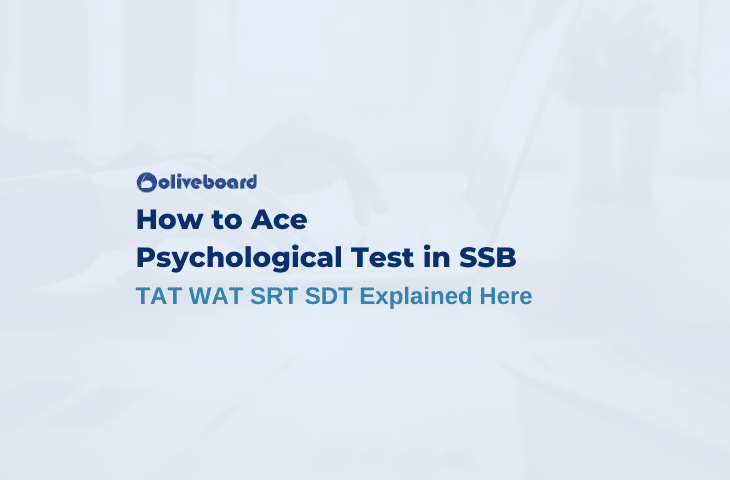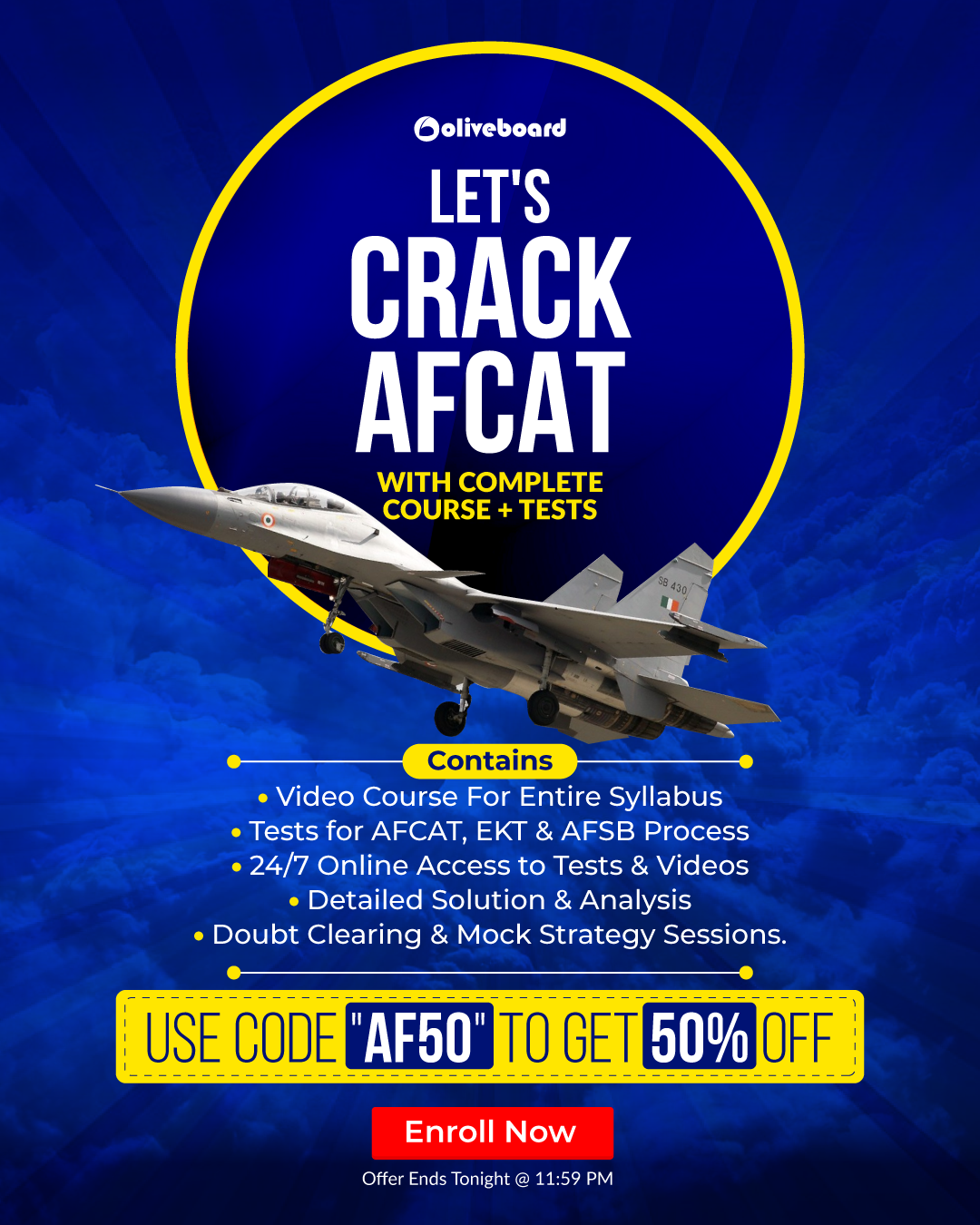The primary purpose of conducting a Psychological Test in SSB is to assess a candidate’s potential in order to become an officer. The tests try to uncover the actual personality traits of an individual and check for their alignment with the desired officer like qualities (OLQs). So here in this blog, we are going to discuss the process of psychological tests in SSB in detail.
Register here for a free AFCAT mock
Introduction and Need for Psychological Test in SSB
The psychological test brings out the true feelings, thought process, and actions of an individual via the help of scientifically proven administered tests with a constrained time-frame and environment. The repercussions of selecting a wrong candidate would be catastrophic and will compromise national security and the lives of other genuine soldiers in some way or the other so there need to be some definite parameters to assess the desired qualities.
The assessors, via psychological test, gauge candidates to ensure that they possess these qualities via delving deep into their sub-conscious and non-conscious state of mind. There are 15 OLQs, on which candidates are judged, which are as follows.
- Effective Intelligence
- Reasoning Ability
- Organizing Ability
- Power of Expression
- Social Adaptability
- Cooperation
- Sense of Responsibility
- Initiative
- Self Confidence
- Speed of Decision
- Ability to influence the group
- Liveliness
- Determination
- Courage
- Stamina
What Psychological Test in SSB consists of?
Out of the five-day testing schedule that takes place in SSB, psychological tests are conducted on the second day. The candidates are administered for the following four psychological tests in the same sequence.
- Thematic Apperception Test (TAT)
- Word Assessment Test (WAT)
- Situation Reaction Test (SRT)
- Self-Description Test (SDT)
Let’s go through these four psychological tests one by one and how to go about attempting each one of the tests. The point to be noted before diving any further is that the language should be kept as simple as possible as a psychology test is not a test of vocabulary or language skills. This applies to all the four psychological tests that we are going to discuss further. In fact, on the contrary, the usage of words that are difficult to comprehend might point towards a lack of clarity and vision and the assessors might believe that the candidates are hiding behind the façade of language and using it as a defense mechanism.
1. Thematic Apperception Test (TAT)
Thematic Apperception Test (TAT) is a projective psychological test in SSB, in which a person’s responses reveal underlying motives, concerns, and the way they see the social world through the stories they make up about the pictures (blurred or otherwise) presented in front of them.
Format
A set of not-so-clear pictures will be shown (11 of them) to the candidates, and based on the picture, the candidates have to write a story based on it. Each picture/image will appear on the screen for 30 seconds and after that, 4 minutes will be given to write a story based on the picture/image shown. This cycle will get repeated for 11 pictures/images and at the end, the 12th one is a blank screen/slide and the candidates are required to write any story from their own minds.
Points to be kept in mind while attempting TAT
- Analyze the background, setup of the story (rural/urban, etc.), foreground, characters (how many of them, their approximate age, profession, etc.) and activities in which they are involved.
- Establish a chief character, which would be the hero of the story, which will have officer-like qualities (OLQs) along with establishing age, gender, profession, etc. of the lead characters and other involved characters as well.
- The story should ideally be broken into three parts: (a) what could have led to the current scene, (b) what is presently going on in the scene and (c) what was the logical outcome eventually, which has to be a positive ending/conclusion.
- The story should be written in the past tense with a positive and constructive mindset. The views conveyed in the story reflects the social attitude and responsibilities that one feels one has towards the others in society.
- Superficial stories (over-heroic stories, wishful stories for instance) need to be avoided as the candidates are suggested to be as practical as possible while writing the story. The main character should be an achiever, who feels and does things for others in society.
- For the last blank screen (12th slide), the candidates can write a story inspired from their own lives or a story of an achiever that they have heard or read and that really touched them.
2. Word Assessment Test (WAT)
Next in line in the psychological test in SSB is the Word Association Test (WAT), which is to evaluate a candidate’s patterns of thought, personality, temperament, achievements, failures, and emotional responses based on the principle of his/her subconscious mind.
Format
A total of 60 words will be flashed, each for 15 seconds and one is required to write the first thought that comes to your mind after reading that word. Some words will relate to one’s intellectual quotient, some to social attributes, some to effectiveness as part of a team, while some would depict dynamism. The entire word-set can be classified broadly under three tones/connotations: positive (love etc.), neutral (pool, etc.) and negative (sorrow, etc.)
Points to be kept in mind while attempting WAT
- The same word (for example, ‘use’) or its different forms (‘useful’, ‘usefulness’, ‘using’ etc.) can be used while framing the sentence.
- Phrases (Honesty is the best policy), idiomatic expressions (A stitch in time saves nine), universal truths (The Sun rises in the east), etc. should be avoided as they show no original thoughts. Sentences depicting or describing the meaning of the word should be avoided too as well.
- Positive, meaningful, and constructive sentences should be framed while avoiding negative and anti-social responses.
- Usage of ‘I’, ‘my’, ‘me’ should be avoided as they show a self-centric attitude. Frame sentences in such a way that they depict at least one OLQ.
- Turn the negative and neutral words into positive by generating a positive response by two methods: (a) Denial method (which denies the negative words by using words like ‘no’, ‘never’ in a sentence) and (b) Remedial method (which remedies the negative word using words like ‘cures’, ‘overcomes’, ‘eliminates’, etc. in a sentence). Take for example, a negative word like ‘Accident’. One can either write ‘Accidents don’t occur if we are careful on-road’ (Denial method) or ‘A stop in drink and drive prevents accidents’ (Remedial method).
3. Situation Reaction Test (SRT)
Situation Reaction Test (SRT) is aimed to test one’s decision-making ability and sense of responsibility. In this test, candidates are supposed to give out intuitive and instinctive responses to a set of unknown, stressful, real-life situations. These are close to real situations, which one may encounter in day to day life.
Format
A total of 60 situations are required to be dealt with within 30 minutes, which means one has 30 seconds for comprehending, analyzing and figuring out and writing down the response for the same.
Points to be kept in mind while attempting SRT
- The response should be methodical (step-wise/structural) and complete in all aspects (starts action but leaves it incomplete, unrealistic responses, etc. need to be avoided at all cost). Also, one needs to keep in mind that the response needs to be precise and to the point and not beating around the bush.
- One needs to always put oneself in the place of the main character and write the response accordingly. Never try to be a superhero with special abilities; qualities of an officer would suffice.
- Immediate action (short to medium term) is desirable rather than futuristic responses (long term). Reactions, which are natural and realistic to oneself, are desirable and should be sought for.
- Asking for help or assistance should be avoided in simple situations (for instance, the bulb got fused, etc.)
- One must show the presence of mind and utilize various recourses available at one’s disposal to their fullest potential while giving out your reaction. Besides, it shall also show one’s general awareness and resourcefulness.
- While giving responses, one must never forget your moral responsibilities towards society and show empathy in your responses while dealing with the ‘feelings of others’.
Attempt a free AFCAT EKT test here
4. Self-Description Test (SDT)
This test gives an idea to the assessors regarding how in-depth the candidate knows himself/herself, whether he/she knows his/her qualities and shortcomings.
Format
In this test, the candidate is required to write 5 paragraphs in 15 minutes on what his/her parents, teacher/employer, classmates/friends/colleagues, candidate’s own opinion about himself/herself, and what qualities he/she would like to develop in the future or what person he/she would like to become in the future. The important thing to be taken care of is that opinions from different persons, as asked in SDT, shouldn’t be contradictory in nature, which points towards discrepancy in the write-up.
Points to be kept in mind while attempting SDT
- Communicate with all the stakeholders involved, and ask for positive and negative opinions about you.
- Avoid extremely negative attributes like short-tempered, addicted to smoking or drinking etc. Be true and frank in the self-description as any mismatch or ambiguity will be easily caught by the esteemed and experienced assessors.
- While writing a perceived area of improvement in each category, make sure not to use very strong language to describe it and also see to it that such shortcoming is not something which is very deep-rooted or unchangeable.
- The personal interview is based on the Self-Description test. The panelists read this before one enters the interview room. So, one needs to be careful about what is to be written in the test.
So keep these points in mind while preparing for AFCAT SSB and stay tuned with Oliveboard for more such articles.
All the best!!
Preparing for SSB?? Click here to attempt free psychological tests
Attempt a Free Mock test for AFCAT

Hello, I’m Aditi, the creative mind behind the words at Oliveboard. As a content writer specializing in state-level exams, my mission is to unravel the complexities of exam information, ensuring aspiring candidates find clarity and confidence. Having walked the path of an aspirant myself, I bring a unique perspective to my work, crafting accessible content on Exam Notifications, Admit Cards, and Results.
At Oliveboard, I play a crucial role in empowering candidates throughout their exam journey. My dedication lies in making the seemingly daunting process not only understandable but also rewarding. Join me as I break down barriers in exam preparation, providing timely insights and valuable resources. Let’s navigate the path to success together, one well-informed step at a time.

